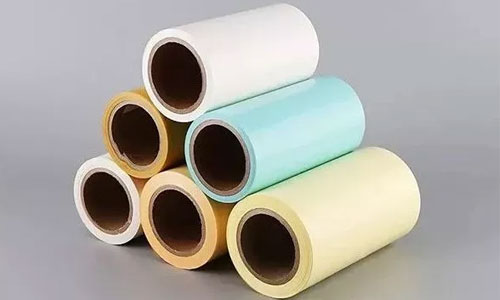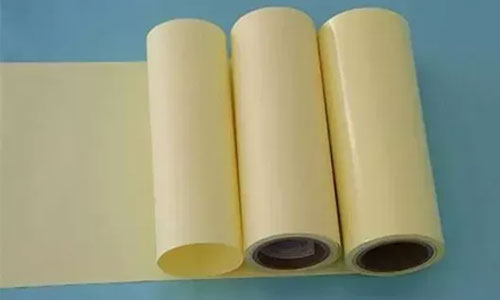Release paper is widely used in many industries nowadays. As someone who uses it, it is not always easy to choose the right release paper. Today, I will discuss some common issues and provide some reliable methods for prevention and solutions. This section is specifically designed to explain the causes of these common issues and provide some recommendations to avoid or correct them.
Film Transfer
Film transfer occurs when the adhesive is not on the correct side of the substrate, resulting in poor unwinding due to adhesive release. Film transfer can be caused by factors such as adhesive bleeding, uneven moisture content, improper winding tension, insufficient curing, or insufficient release force of the release material.

Foaming/Bubbling
Foaming is a phenomenon of damage that occurs on the surface of substrates, coating films, adhesive coatings, etc. When liquids such as water or organic solvents, or gases such as air, expand at a rate faster than the system can dissipate the increased volume and pressure, foaming usually occurs. For example, when both sides of a PEK release paper are heated to a high temperature, the PE softens, and when the steam pressure from the water in the paper is high enough, bubbles form in the PE to release the pressure.
Foaming can be caused by the following reasons:
- Overheating
- Restricted penetration/dissipation of the liquid/vapor components in the system
- Evaporation of solvents or water
The following practices can minimize bubbles:
- Lower the maximum temperature
- Slow down the heating rate
- Use release materials with better air and water permeability
Adhesion
Adhesion occurs when multiple layers of release materials are fused together, making it difficult to unwind without damaging the paper or using high unwinding tension. Adhesion can occur either in certain parts of the paper, such as edges, or throughout the entire sheet, and can be caused by various mechanisms.
- Insufficient curing of silicone oil
- Uneven moisture content
- Excessive wind-up tension
- Chemical contamination
- Insufficient release force
Adhesion can be prevented through various methods:
- Improve the curing process
- Lower the environmental humidity and improve storage conditions
- Decrease tension by reducing roller pressure, increasing winding tension taper, or reducing torque
Many people also use noise as an indicator of adhesion. However, this method is highly subjective and does not guarantee adhesion because some coatings inherently have a "non-slip" or "adhesive" property when touched.
Delamination
Delamination refers to the separation of bonded layers at the interface, either mechanically or chemically. Delamination can occur at the interface between PE and paper or between adhesive and silicone oil.
Delamination is often caused by material and interface issues. For example, delamination of PEK-coated release paper is due to poor surface treatment before the PE coating. Adhesive delamination may be caused by the easy release of silicone oil.

Delamination can be caused by the following factors:
- Improper flame or chemical surface treatment.
- Poor internal bonding.
- Weak internal cohesion between fibers.
- Improper release force of silicone oil coating (too light).
Delamination can be corrected by the following methods:
- Improved surface treatment.
- Enhanced internal bonding of the substrate.
- Increase in release force of silicone oil coating.
Dimensional Stability
Dimensional stability refers to the ability of a material to resist size changes when exposed to external forces such as moisture, high temperatures, or physical pressure. All materials undergo some degree of size change when exposed to these external forces. The challenge lies in controlling the extent of these changes to ensure product quality is not compromised during processing and use.
For paper, moisture gain or loss is a major concern, as it can cause curling, edge warp, or poor flatness. The dimensional stability of paper is influenced by various factors, including fiber type and percentage, refining degree, fiber bonding, filler content, sizing type and amount, fiber orientation, drying process, sheet density, and construction. Subsequent processing steps also affect the dimensional stability of release paper.
Dimensional stability is also a factor for release films, but it is caused by thermal pressure. Exposing release films to high temperatures, especially under tension, can cause shrinkage, stretching, or severe deformation.
Factors influencing dimensional stability include:
- Variations in humidity.
- Initial moisture content of paper during production.
- Percentage and type of pulp.
- Drying process of paper.
- Fiber fines.
- Filler content.
- Sheet density and construction.
Poor Slackness of Film and Paper
Poor slackness of the film and paper occurs when there is uneven tension on the surface of the substrate. It results from the unequal length of the entire span of incremental zones on the paper surface, leading to different levels of tension.
Poor slackness of the film and paper is a characteristic that arises during the processing of the substrate. Slackness can be mitigated or minimized through cooling treatment of the film.
Causes of poor slackness include:
- Uneven paper thickness.
- Over-tight winding.
- Uneven thickness of surface winding.
- Improper relaxation.
- Improper drying.
Remedies for correcting poor slackness include:
- Reducing thickness differentials.
- Using a differential slip mode for rewinding.
- Adjusting relaxation devices to achieve uniform paper tension.
- Reducing oven temperature gradients.
Flatness
Flatness is typically considered as the ability of a release paper or finished product structure to resist curl when exposed to variation in humidity. It is fundamentally related to the dimensional stability of the release paper. However, other factors such as improper tension during lamination, substrate shrinkage, exposure to high temperatures, or roller settings can also cause curling or flatness issues.
Flatness can be optimized by:
- Using release paper with high dimensional stability.
- Applying appropriate machine tension during lamination.
- Minimizing substrate shrinkage.
- Avoiding exposure to high temperatures.
Moisture Wrinkling
Most papers are made from dispersed fibers suspended in water. Most of the water is removed during the manufacturing process. However, paper has the ability to absorb or lose significant amounts of moisture during additional handling or storage processes. Water absorption often leads to moisture wrinkling, especially in the outer layers of a paper roll or in the surface of paper-based products.
Coated papers, over-calendered kraft papers, and PE-coated papers can lose or absorb moisture during heat treatment or storage. Papers with low moisture content absorb water very quickly, resulting in moisture wrinkles typically seen on the outer layers. After the thermal treatment step, remoistening the paper minimizes the possibility of wrinkles due to subsequent water uptake. Proper moisture-resistant packaging and storage conditions are also important.
Moisture wrinkling can be caused by the following:
- Over-drying of paper during processing.
- Long exposure to low humidity environment.
- Long exposure to high humidity environments.
Methods to minimize or eliminate these effects include:
- Remoistening paper rolls after thermal processing.
- Controlling storage environment and using moisture-resistant packaging.
Scratches
Scratches are physical abrasions that occur on the surface of release materials due to contact with uneven or harder surfaces. Scratches can occur when there is a mismatch between line speed and surface processing. As a result, the softer surface is damaged, usually the coating or substrate surface. Scratches can also occur when the machine experiences longitudinal or transverse slipping due to uneven tension throughout the process. Proper alignment and tension control of paper rolls are necessary during processing.
Scratches are caused by the following factors:
- Differences in line speed and substrate speed.
- Rapid and significant variations in surface morphology.
- Misalignment of idler wheels and incorrect tension settings.
Scratches can be eliminated through the following methods:
- Matching the speed of the paper to the speed of the idler wheel.
- Ensuring uniform surface morphology.
- Maintaining consistent paper tension throughout the process.
- Ensuring the machine is properly calibrated.
Silicone Oil Transfer
Silicone oil transfer refers to the transfer of silicone oil coating from one surface to another. This transfer is typically caused by non-reactive components or insufficient curing of the silicone oil coating. Silicone oil transfer usually occurs on the backside of the substrate or adhesive surface. The transfer can be detected by changes in the surface energy on the backside of the substrate. Additional methods to determine silicone oil transfer to the adhesive include Electron Spectroscopy for Chemical Analysis (ESCA) and subsequent adhesion testing on metal plates.
Silicone oil transfer is caused by the following factors:
- Insufficient curing of the silicone oil.
- Excessive or inadequate surface treatment.
- Excessive winding pressure.
- Non-reactive organic silicone polymers.
The following methods can reduce silicone oil transfer:
- Enhancing the level of silicone oil curing.
- Ensuring sufficient surface energy of the coating; surface energy levels should not be excessively high.
- Reducing winding tension.
Static Electricity
Static electricity refers to the accumulation of static charges on the surface of the substrate. These charges can be either positive or negative.
Static electricity is generated when two different surfaces are separated, causing the transfer of charges from one surface to another through frictional effects. Pressure, friction, line speed, humidity, and surface smoothness all influence the generation and transmission of static charges.
If static control equipment is not used during the processing, roller voltages can often exceed 50,000 volts. Depending on the distance between charges, corona discharge can occur at levels as low as 4,000 volts. Therefore, if the line potential is not reduced to acceptable levels, there can be physical hazards to operators and equipment. Corona discharge also affects the moisture and continuity of coatings. Poor release can occur in the case of silicone oil coatings.
Static electricity can be controlled through the following methods:
- Keeping the surface of the substrate as close as possible to the static eliminator.
- Increasing humidity levels (surface moisture).
- Using passive and air-assisted ion bars and blowers.
Wrinkles
Wrinkles are defined as the transverse folding of the paper. The occurrence of folds is due to uneven tension distribution and the failure of transverse edge alignment. Wrinkles are typically classified as hard wrinkles or soft wrinkles, and their effects vary depending on the application.
The main causes of wrinkles are:
- Insufficient transverse machine tension.
- Traction loss between the paper and idler wheels.
- Poor machine calibration.
- Poor substrate sagging.
Correction measures for the above issues include:
- Applying a spreading roller.
- Improving edge guiding devices to ensure even paper feeding.
- Checking the machine calibration and using optical alignment if necessary.
Contact: Pamela
Phone: +86 189 6365 3253
E-mail: info@industryprocess.com
Whatsapp:+86 189 6365 3253
Add: Yajing Industrial Park, No. 59 Shuangjing Street, Weiting Town, Suzhou Industrial Park
We chat
